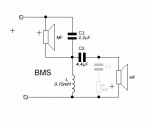Appreciate your thoughts and input - thanks a lot.
I tried many different approaches of measuring, - not including the free space 4m thing yet though :0) All methods showed the same pattern, except for the off-axis measurements - thus the idea of trying out the power response approach.
Actually my main concern with this speaker has been to achieve a smooth response in the 3-12kHz area. I have a 6 db dip in the response at 4.8kHz requireming a massive narrow band rise on the EQ, - and a strange sudden rise in the 10-18kHz area that needs a lot of EQ to get a flat FR. I am also cutting some 2.9kHz and some other small corrections, but they are not that important. The result after applying the EQ specifically in the 4.8kHz and damping the 13kHz peak is not just bright but unpleasantly sharp, as if something is missing.
If I introduce a small rise in the 7.5kHz Q:4 +2dB things start to fall into place in the treble area, where hi-hats and metal intruments etc. starts to sound smooth and real, - but the measured FR is definitely not flat anymore.
Could it be due to the mic's I am using? (the rest of the signal path is calibrated - I even made an L-PAD and measured the output of my amps - to rule that out also :0))
I have tried two mic's one is a DBX RTA M1 and the other is a Behringer UMC8000 and found that there is quite a bit of variation in the VHF. (see enclosed screen shot of HF and VHF separately on BMS passive filter. Pink is RTA and green is UMC). Notice the 10dB scale.

Could the mic's and their respective calibration files be the cause of all my trouble?
Thanks again for all the inputs, suggestions and explanations.




